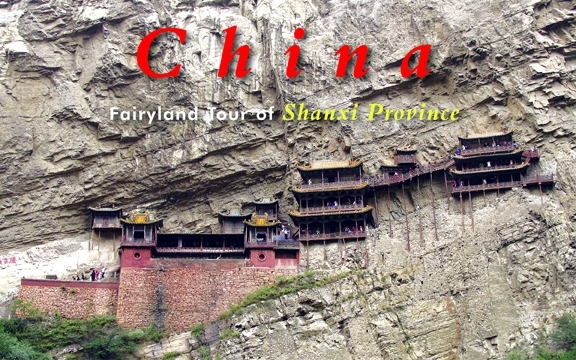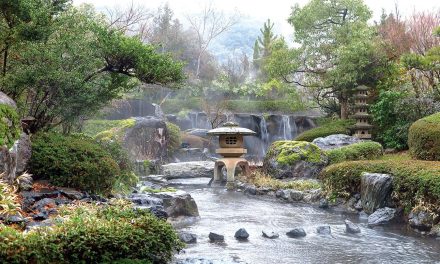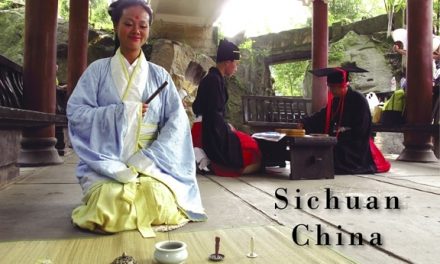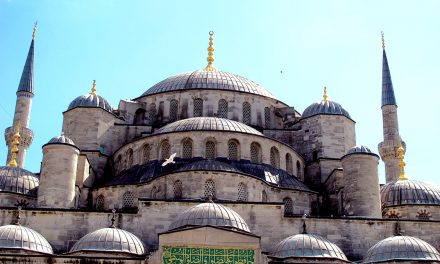China
Fairyland Tour of Shanxi Province
Article & Photography by Michael Morcos

Jinci Temple
As one of the oldest wooden structures in the country, the Jinci Temple (Jin Ancestral Temple) is a combination of historical and cultural relics located within a beautiful landscape.
The multitude of ancient trees provides an eye-catching entrance to welcome visitors, and the majesty continues throughout the vaulted halls, cabinets, pavilions and bridges. The Temple is renowned because it is an ancient ancestral temple, something which is quite rare in China. There are also nearly three hundred tablets inscribed with writings by emperors, officials and poets lining a scenic path in the temple.
Colorful shows
The Chinese have made a name for themselves with spectacular displays of choreography, light and music. The Olympic Games in Beijing showed the world the prowess of the country’s festive nature!
Dances and lively music dates back to the Tang Dynasty and there are many different shows to enjoy. The productions include numerous costume changes, historic musical instruments, professional singing and dancing. The shows really have it all, with non-stop lights, sounds and colours!
The dancers are exceptional and trained to perfection, seamlessly running through their dance sequences. Some of the shows include dinners, much like in north America, but with a Chinese flair!
The Qiao family courtyard
The Qiao Family Courtyard is another masterpiece of traditional civil architecture, and was the house of the well-know financier Qiao Zhiyong of Qing Dynasty and the compound has been turned into a magnificent complex for visitors.
Qiao Family Compound has 6 large yards and 20 small yards including 313 houses. It was built so that when you look down at the overall yard above ground that looks just like”喜喜” (double happiness in Chinese)!
From the outside, the straight stone pavement divides into 6 courtyards and the Qiao family’s ancestral temple directly faces the gate. There are 4 main buildings and 6 other structures including the Geng and Tiao pavilions. The sidewalks on the roof of every yard are connected to allow for a great stroll above the yards. The doors, windows, eaves, and stone stairs are all beautifully shaped. Brick carvings are everywhere in the yards and are based on figures, flowers and plants, birds, painting and calligraphy and are exquisite for their workmanship and quality is second to none.
There is also a Folk Museum that features art, science, and more, and has 42 exhibition rooms displaying a wide range of material covering the history, food, clothing, and transportation, wedding and funeral ceremonies, and agriculture trade activities of the area. More than 2,000 pieces reflect the folktale custom of the Shanxi Jinzhong area.
The City of Pingyao
The city is famous for the immense wall and the main attraction is the city itself. A walkabout will astound the history buff, as nearly every building dates from the Ming (1368-1644) or Qing (1644-1911) Dynasties. Making it even better is the car-free status and ancient street plan that make it easy to enjoy a stroll and adds to the ancient atmosphere.
The wall of the city is a treasure of its own, and is shaped like a tortoise–a traditional Chinese symbol of longevity–with the south gate and north gate representing the head and tail respectively. It is over 600 years old and has a series of 72 watchtowers and a moat.
The Rishengchang Exchange House was developed as an answer to the dangers experienced along the extensive trade routes. As Pingyao is at the centre of these trade routes, and in 1823 the first piaohao (“exchange house”, “draft bank,” or “remittance shop”) was opened to provide remittance services, accept deposits, and make loans. As a result, the Rishengchang, or “Sunrise Prosperity,” was the first exchange house and soon Pingyao became the center of the nation’s banking industry. Rishengchang survied for 108 years before collapsing in 1932, and the historical societies have refurbished a number of other piaohao buildings and opened them to tourists.
Ming & Qing Shopping Street
Named after two of china’s greatest dynasties, this sector has been the main comercial avenue in Pingyao for centuries, with hundreds of shops lining the busy streets. Though many storefronts date back to these ancient dynasties, many traditional-style shops line the street and sell food, snacks, local specialities, art, furniture, calligraphy, and souvenirs. Here you will also find the City Tower, which at 18.5 meters it is the tallest structure in the city and offers a great view.
The Hongshanyi guest house
This beautiful old fashioned style guesthouse/hotel has been lovingly restored and offers ancient courtyards, and though the rooms are on the small side, the service and location are perfect. Located just off the Main Street, access to the tourist and shopping areas is just a doorway away and guests can hear the karaoke music and loud nightlife that can have you enjoying and exploring deep into the night!
Mt. Wutai
Considered as the most holy land of Chinese Buddhism, Mt. Wutai offers beautiful scenery and is a true masterpiece of nature. Besides the religious aspect, visitors can explore the peaks and valleys, passing through clouds on the way up and enjoying the sunset. The natural beauty of the mountain ridges, exotic rocks, gullies, clear waters and green forests makes it easy to see why the mountain is a colorful and notable scenic resort!
Buddhist Temples
It is said that this mountain is where Manjusri Bodhisattva resides and over 360 temples were built here, with some dating back to the Tang Dynasty (618-907). Sadly only 47 of them remain, yet untold numbers of pilgrims and visitors have visited these magical spaces. Among these magnificent temples, there are four that stand out.
Oldest and most prestigious among these is the Xiantong Temple, a palace of 80,000 square meters and build in the year 68! Today it is one of the most important temples as the Buddhist Association of Mt. Wutai calls it home. The copper bell in front of the gate is the biggest bell on the mountain, weighing over 22,000 pounds and it can be heard around the entire mountain.
Datong
The Hanging Temple was built in 491 and has survived more than 1400 years. Its uniqueness has brought construction experts from around the world come to see the monastery. Hanging from the side of a mountain, it mixes mechanics and aesthetics, and symbolizes the great architectural achievements of Chinese people.
Yingxian Wooden Pagoda features hidden floors and windows that offer views from all 8 sides of the building up to 30 kms on a clear day. There are also zaojings carved into the ceiling of every story of the pagoda.
The Huayan Monastery complex is located on Daxi Street on the south western side of Datong City and is the largest and most well preserved monastery of the Liao Dynasty in existence in China. It is small and intimate, and a lovely place to meditate and view some history.
Lastly the Yunggang Caves were built in northern Wei Dynasty 1,500 years ago and are called ‘The Art Treasure of Eastern Caves and is very famous for its wonderful stone carvings. The Yungang Grottoes, have 252 caves and 51,000 statues, represent the outstanding achievement of Buddhist cave art in China and constitute a classical masterpiece of the first peak of Chinese Buddhist art.
www.tourismchina.org
Click on cover to view published article


















